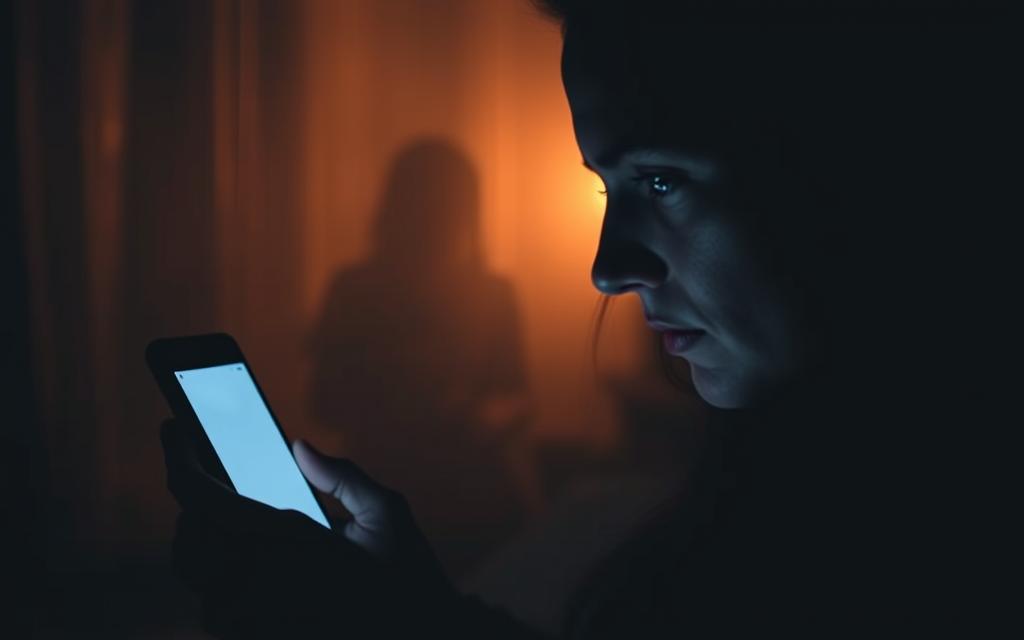Remember when cheating meant sneaking love letters or late-night phone calls? Today, a single DM or casual Instagram like can blur lines between loyalty and betrayal. Platforms designed for connection now create unexpected challenges for modern relationships.
Unlike handwritten notes hidden in drawers, digital interactions leave invisible footprints. Swipe-based apps and 24/7 messaging create endless opportunities for secrecy. A quick chat vanishes with one tap, while dating profiles stay tucked behind password-protected screens.
This constant access changes how people approach commitment. Emotional affairs now bloom through TikTok comments before physical meetings occur. Partners might share memes with exes while lying next to each other in bed – actions that feel harmless yet erode trust over time.
What makes these behaviors so tempting? Convenience and perceived anonymity. A flirty exchange feels less “real” than traditional cheating, even when it hurts just as much. Digital breadcrumbs – deleted texts or hidden chat folders – make suspicion harder to prove but easier to fuel.
As we explore this landscape, we’ll uncover how constant connectivity reshapes what fidelity means. The real question isn’t just about right or wrong, but how relationships adapt to love in the age of endless digital options.
The Digital Shift: Redefining Infidelity in the Modern Age
Digital tools have transformed how people cross emotional lines. Where folded paper once carried secret feelings, encrypted chats now hide flirtations. This evolution makes modern loyalty tests harder to navigate than ever.

Technology and Changing Definitions
Relationship boundaries now stretch across screens. A late-night Snapchat or nostalgic comment under an ex’s post can spark arguments. Many couples disagree on whether liking thirst traps counts as cheating – proof that digital age norms keep shifting.
Platforms like Instagram and WhatsApp enable constant, discreet messages. Partners might share private jokes in hidden chat folders while appearing loyal offline. These exchanges often feel less “serious” than physical affairs, yet they erode trust just as effectively.
From Secret Love Letters to DM Confessions
Old-school infidelity required effort: buying stamps, finding hiding spots. Today’s version happens faster than a fingerprint unlock. “Sliding into DMs” has become a cultural meme – and a common relationship stressor.
Three ways tech changes fidelity rules:
- 24/7 access to old flames via social media platforms
- Disappearing messages that leave no evidence
- Plausible deniability (“We were just memeing!”)
What once took weeks of planning now happens during a coffee break. The digital age didn’t invent cheating – it just made the stakes murkier.
Social Media Platforms and Opportunity for Infidelity
Platform algorithms keep serving up connection possibilities like endless appetizers. Swipe-right culture and personalized suggestions turn casual scrolling into relationship minefields. A single tap now bridges the gap between curiosity and action.

Always-On Access Breeds Temptation
Smartphones transform media platforms into 24/7 temptation hubs. Dating apps suggest matches during lunch breaks, while Instagram stories revive old flames. These tools create impulse pathways – quick decisions made without considering consequences.
Three dangerous combos emerge:
- Private messaging features in work apps
- Disappearing photo modes on camera-first platforms
- Anonymous accounts for secret browsing
Hidden in Plain Sight
Modern apps offer relationship escape hatches. Encrypted chats let users send self-destructing texts, while alt accounts hide flirtatious interactions. Partners might maintain seemingly clean main profiles while running secret side accounts.
Platforms enable compartmentalization through:
- Separate chat folders for different contacts
- Custom privacy settings for specific followers
- “Incognito” modes for stealth browsing
This digital sleight-of-hand creates plausible deniability. A partner could be using digital detective tools while appearing fully present offline. The gap between online actions and real-world accountability keeps widening.
The impact of social media on infidelity rates
Scrolling through endless feeds might seem harmless, but research reveals hidden costs for romantic partnerships. A 2023 study found couples spending 2+ hours daily on platforms face 32% higher separation risks. Why? Constant notifications chip away at face-to-face moments that build lasting bonds.

- 45% of marriage counselors report secret messaging as top conflict trigger
- Weekly arguments double when partners use apps during shared meals
- 62% feel less emotionally secure after spotting flirty comments
Platforms designed for connection ironically fuel disconnection. Partners might sit together yet mentally wander through exes’ profiles or relationships rekindled in group chats. This digital drift creates invisible wedges – no slammed doors required.
Trust erodes through subtle actions: deleting chat histories, muting stories from specific followers, or keeping separate “friendship” accounts. Over time, these behaviors normalize secrecy. What begins as harmless scrolling can morph into emotional detachment that physical affairs rarely achieve.
As screen time increases, relationship satisfaction scores plummet. Therapists note clients now struggle to differentiate between online politeness and genuine betrayal. This confusion sets the stage for micro-cheating behaviors we’ll explore next.
Emotional Affairs and Micro-Cheating in the Digital Era
The digital age has introduced new battlegrounds for trust and loyalty in love. Unlike physical affairs, emotional betrayals now unfold through screens – silent yet seismic shifts in commitment. Micro-cheating thrives in this gray area, where a heart emoji or private playlist shared with a coworker can fracture relationships.

Identifying Subtle Signs Online
Red flags often hide in plain sight. Partners might save a contact under fake names, religiously clear chat histories, or spend hours liking someone’s posts. These digital breadcrumbs signal emotional energy being diverted elsewhere:
- Prioritizing responses to a specific friend’s messages
- Creating inside jokes through meme exchanges
- Consistently hiding phone screens during conversations
Consequences on Emotional Intimacy
When one partner invests feelings in digital media connections, real-world bonds wither. Shared laughter becomes forced, and vulnerable conversations feel risky. Studies show 58% of people experiencing emotional affairs report chronic anxiety about their primary relationship’s stability.
Three mental health impacts emerge:
- Sleep disturbances from late-night messaging habits
- Depression linked to perceived inadequacy
- Trust issues spilling into other relationships
Rebuilding emotional intimacy requires acknowledging these small betrayals early. Partners who discuss digital boundaries openly often prevent minor slips from becoming avalanches.
Digital vs. Physical Infidelity: Blurred Boundaries
A midnight text holds different weight than a hotel receipt, yet both leave scars. Modern relationships face a paradox: physical affairs leave tangible evidence, while digital slips hide in cloud storage. This gray area challenges how couples define loyalty.

The Question of Intent
Does sending heart emojis to a coworker equal physical emotional cheating? Experts argue intent matters most. Digital interactions often start innocently – sharing memes or venting about bad days. But repeated partner cheating behaviors emerge when:
- Messages include intimate details about the relationship
- Conversations happen during designated “couple time”
- Deleting histories becomes routine
Trust and the Erosion of Relationship Integrity
Crossing digital boundaries creates cracks in trust foundations. A 2022 study found 73% of betrayed partners rated secret texting as hurtful as physical affairs. Why? Hidden actions suggest prioritization of external connections over the primary bond.
Three silent trust-killers:
- Private social media accounts for “friends only”
- Using work apps for physical emotional exchanges
- Gaslighting about online interactions
Rebuilding boundaries requires mutual honesty. Partners who discuss digital comfort zones early often prevent misinterpretations. Remember: secrecy, not the platform itself, usually signals partner cheating tendencies.
Effects of Social Media on Relationship Trust and Communication
Dinner tables now host glowing screens alongside plates. Partners often share physical space while mentally orbiting separate digital worlds. This constant split attention reshapes how couples connect – or fail to.

Disrupted Conversations and Quality Time
Smartphones create a communication paradox: endless connectivity with strangers, fractured exchanges with loved ones. A 2024 study found couples lose 18 minutes of meaningful dialogue daily to app checks – equivalent to 4.5 days yearly. These micro-distractions accumulate into emotional debt.
Three common patterns emerge:
- Mid-sentence pauses to scroll notifications
- Repeated “What did you say?” moments during shared meals
- Postponed discussions for social media browsing
Overexposure to online interactions trains brains to prefer quick dopamine hits over deeper bonding. Partners might discuss vacation plans while simultaneously reacting to others’ Instagram stories. This divided focus breeds feelings of neglect, even when physically together.
Quality time suffers most. Weekend getaways become photo ops rather than connection opportunities. Date nights get interrupted by work Slack pings disguised as urgent. The ripple effect? 63% of surveyed couples report increased arguments about perceived indifference.
Rebuilding trust starts with screen-free zones. Successful partners often:
- Designate device-free hours after work
- Use app timers to limit mindless scrolling
- Schedule weekly “tech check-ins” to discuss digital boundaries
Like tending a garden, relationships thrive when given undivided time and attention. Small changes in phone habits often yield big improvements in emotional availability.
Influence of Social Media on Marital Satisfaction and Divorce Rates
Marriage counselors now track screen time alongside communication patterns. A 2024 study revealed couples with joint social media accounts show 40% higher satisfaction rates than those maintaining separate digital lives. But when platforms become battlegrounds, the fallout often lands in courtrooms.
Statistical Insights and Trends
Data paints a stark picture. Heavy Instagram users face 2.3x higher divorce risks within five years of marriage. Facebook’s “People You May Know” feature correlates with a 20% spike in marital dissolution cases among users aged 25-34. Three concerning patterns emerge:
- 53% of contested divorce cases now cite digital evidence
- Couples under 30 report 68% more jealousy triggers from apps
- 35% of marriage therapists note increased legal consultations about online behavior
Curated feeds create unrealistic benchmarks. Partners compare their relationships to influencers’ highlight reels, fostering dissatisfaction. A 2023 Yale study found 58% of frequent scrollers believed others had “perfect marriages” – compared to their own struggles.
From a legal perspective, digital infidelity complicates asset divisions and custody battles. Screenshots of flirty DMs often become Exhibit A in courtrooms, especially in no-fault divorce states.
Age plays a critical role. Millennial couples experience 22% more social media-related conflicts than Gen X pairs. Yet younger generations also pioneer solutions – 41% create “digital prenups” outlining online behavior expectations.
As platforms evolve, so will law practices. Some attorneys predict specialized “digital infidelity clauses” becoming standard in marriage contracts. The future of relationships may hinge on balancing connection apps with real-world commitment.
Reconnecting with Exes and Online Temptations
Coffee dates with exes now begin with a Facebook friend request. Platforms make revisiting past flames as easy as typing a name into search bars. What starts as curiosity about an old flame’s vacation photos can spiral into emotional entanglements that threaten current bonds.
Old Flames and Digital Reunions
Casual messages like “Remember when…” often act as gateways. A 2023 study found 1 in 3 adults admitted to messaging former partners while in committed outside relationships. These exchanges frequently escalate through:
- Late-night nostalgia chats
- Secret Zoom catch-ups
- Liking every post in someone’s feed
Shared memories gain new intensity through screens. Partners might downplay interactions as harmless, yet 42% of couples report feeling uneasy about their someone partner maintaining contact with exes. The line between friendly and flirtatious blurs when conversations become regular rituals.
Setting Clear Relationship Boundaries
Healthy partnerships require mutual understanding of what crosses the line in digital interactions. Transparency prevents misunderstandings – like agreeing whether following an ex’s private account counts as betrayal. Three boundary-setting strategies:
- Discuss comfort levels with past connections early
- Establish “no contact” rules for specific platforms
- Share passwords as trust-building gestures
Actions that feel innocent often carry hidden risks. Saving an ex’s number under a fake name or deleting chat histories creates secrecy – a red flag in any outside relationship. Successful couples create digital guardrails that protect their sense of security while respecting individual privacy needs.
Privacy Concerns and Jealousy Stemming from Online Behavior
Ever caught yourself checking a partner’s phone notifications? That flicker of curiosity reveals how digital spaces fuel modern insecurities. Constant access to others’ lives breeds new forms of relational friction, turning devices into both tools and traps.
Digital Monitoring and Trust Issues
Partners who demand password access often spark unintended conflicts. A 2024 study found 68% of couples argue about device checks weekly. Snooping through messages rarely builds trust – it usually creates resentment. Three common patterns emerge:
- Demanding real-time location sharing
- Using parental controls to limit a person’s app usage
- Secretly logging into a partner’s accounts
These actions often backfire. Someone who feels monitored might create secret accounts, worsening the cycle. Relationship issues escalate when privacy violations become routine.
Mental Health Impacts and Relationship Strain
Seeing a partner’s chat with someone else can trigger anxiety spikes. Therapists report increased cases of sleep disorders linked to late-night scrolling through a person’s social feeds. The brain struggles to distinguish between real threats and algorithm-driven paranoia.
Platforms amplify tensions unintentionally. Tag suggestions might reveal hidden connections, while “active now” statuses feed suspicions. Partners often misinterpret innocent interactions as betrayal cues, leading to communication breakdowns.
Healthy boundaries help prevent these issues. Experts recommend:
- Discussing comfort levels with access to devices
- Agreeing on what counts as private vs. shared spaces
- Scheduling tech-free hours to rebuild in-person connections
Trust thrives when both partners feel respected – not surveilled. Balancing transparency with personal space remains key in our device-driven world.
Strategies for Setting Digital Boundaries in Relationships
Phones shouldn’t feel like third wheels in your relationship. Building healthy digital boundaries starts with treating tech as a tool – not a rival. Relationship coaches emphasize that small, consistent actions create safer emotional spaces than rigid rules.
Talking It Out: The First Step
Start with a “tech check-in” over coffee. Share how different platforms make you feel without accusations. Try: “I get anxious when we scroll during dinner – could we try device-free meals?” This way of framing focuses on connection, not control.
Smart Habits for Connected Couples
Turn intentions into actions with these expert-backed tips:
- Sync phone Downtime modes to limit late-night app use
- Create a shared album for posting couple photos instead of endless scrolling
- Use platforms like Freedom or StayFocusd to block distracting sites during quality time
Regularly revisit your agreements. What worked during dating might need tweaks after moving in together. A monthly “relationship reset” chat helps adapt boundaries as life changes.
Remember: the goal isn’t to police each other’s screens. It’s about finding a way to use social tools mindfully while protecting your real-world bond. Couples who approach tech as a team often discover deeper trust – and better sleep habits from fewer midnight notifications!
Navigating the Legal and Emotional Implications
Legal paperwork now includes screenshots alongside signed affidavits. Digital breadcrumbs from affairs carry weight in courtrooms and therapy sessions alike. What begins as midnight DMs can spiral into custody battles or clinical depression.
When to Seek Professional Help
Persistent anxiety about a partner’s interactions social habits often signals deeper issues. Therapists recommend intervention when:
- Sleep patterns change due to message-checking compulsions
- Work performance suffers from relationship stress
- Secret accounts multiply despite promises to stop
Counselors help people distinguish between harmless flirting and cheating still behaviors. Early sessions can prevent emotional avalanches before they bury relationships.
Legal Perspectives in the Digital Age
Attorneys report a 57% increase in cases using Instagram DMs as evidence. Digital affairs complicate divorce proceedings through:
- Asset division disputes over shared streaming accounts
- Custody battles influenced by inappropriate chat histories
- Alimony adjustments based on dating app activity timestamps
Courts now treat deleted messages as concealment attempts. One 2023 ruling awarded 63% of marital assets to a spouse who proved years of hidden interactions social platforms use.
Conclusion
Modern relationships now navigate minefields their grandparents never imagined. Digital tools reshape loyalty tests, turning casual likes into potential betrayals. Studies show 45% of conflicts stem from secret messages, while 62% report eroded trust after spotting flirty comments.
Rebuilding connection starts with honest talks about comfort zones. Partners thrive when creating device-free hours and shared digital agreements. For those struggling, exploring the psychology behind infidelity offers clarity on why digital temptations arise.
Every scroll carries consequences. By setting clear boundaries and prioritizing real-world bonds, couples can transform tech from threat to tool. The healthiest relationships aren’t screen-free—they’re built on mutual awareness in our always-connected age.

Spy-loop helped me monitor his phone.